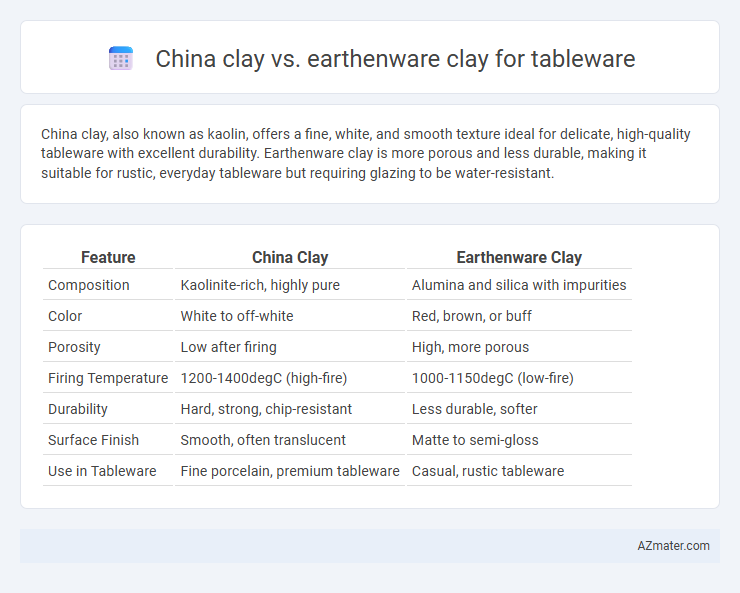China clay, also known as kaolin, offers a fine, white, and smooth texture ideal for delicate, high-quality tableware with excellent durability. Earthenware clay is more porous and less durable, making it suitable for rustic, everyday tableware but requiring glazing to be water-resistant.
Table of Comparison
| Feature | China Clay | Earthenware Clay |
|---|---|---|
| Composition | Kaolinite-rich, highly pure | Alumina and silica with impurities |
| Color | White to off-white | Red, brown, or buff |
| Porosity | Low after firing | High, more porous |
| Firing Temperature | 1200-1400degC (high-fire) | 1000-1150degC (low-fire) |
| Durability | Hard, strong, chip-resistant | Less durable, softer |
| Surface Finish | Smooth, often translucent | Matte to semi-gloss |
| Use in Tableware | Fine porcelain, premium tableware | Casual, rustic tableware |
Introduction to China Clay and Earthenware Clay
China clay, also known as kaolin, is a fine, white, and pure clay primarily composed of kaolinite, prized for its strength and translucency in tableware production. Earthenware clay, characterized by its porous and coarse texture, contains higher levels of iron and other impurities, resulting in a naturally warm and rustic appearance after firing. The distinct mineral compositions of china clay and earthenware clay influence their firing temperatures, durability, and final aesthetic qualities in tableware manufacturing.
Composition and Raw Material Differences
China clay, also known as kaolin, is a pure, white clay primarily composed of the mineral kaolinite, renowned for its high alumina and low iron content, which imparts strength and whiteness to tableware. Earthenware clay contains a higher proportion of iron, lime, and other impurities, resulting in a more porous and less vitrified final product with an earthy texture and natural reddish or brownish hues. The differing mineral compositions affect their firing temperatures and durability, with china clay requiring higher firing temperatures for vitrification compared to the lower firing range of earthenware clay.
Physical Properties and Workability
China clay, known for its fine particle size and high purity, offers excellent plasticity and smooth texture, making it ideal for intricate tableware designs and thin-walled pieces. Earthenware clay contains larger, more irregular particles and higher silica content, resulting in a more porous, less vitrified surface that can be heavier and less durable for everyday tableware use. Workability of china clay is superior due to its consistent plasticity and minimal shrinkage, whereas earthenware clay requires careful handling to avoid cracking and warping during drying and firing.
Firing Temperatures and Techniques
China clay, or kaolin, typically requires higher firing temperatures ranging from 1200degC to 1400degC, producing a hard, vitrified surface ideal for fine tableware with excellent durability and a smooth, white finish. Earthenware clay fires at lower temperatures between 1000degC and 1150degC, resulting in a more porous, softer material that often necessitates a glaze to make the tableware waterproof and suitable for everyday use. Techniques for china clay include high-temperature electric or gas kilns to achieve vitrification, while earthenware clay is commonly fired in oxidation or reduction atmospheres using traditional or electric kilns.
Durability and Strength Comparison
China clay, also known as kaolin, offers superior durability and strength due to its fine particle size and high purity, making it ideal for producing strong, chip-resistant tableware. Earthenware clay contains more impurities and larger particles, resulting in a more porous and less durable material that is prone to chipping and cracking under regular use. For long-lasting tableware, China clay provides enhanced mechanical strength and resistance to thermal shock compared to traditional earthenware.
Porosity and Water Absorption
China clay, also known as kaolin, exhibits low porosity and minimal water absorption, making it ideal for durable and non-porous tableware. Earthenware clay typically has higher porosity, resulting in increased water absorption, which can affect the strength and hygiene of tableware items. The dense, fine particle structure of china clay ensures superior resistance to staining and moisture penetration compared to the more porous earthenware clay.
Color and Finish of Final Products
China clay, also known as kaolin, produces tableware with a bright white color and a smooth, refined finish, making it ideal for elegant and minimalist designs. Earthenware clay results in warmer, more rustic hues ranging from reddish-brown to terracotta, offering a matte or slightly textured surface that enhances handcrafted aesthetics. The opacity in China clay enhances glaze vibrancy, while earthenware's porous nature often requires thicker glazes for a glossy finish.
Suitability for Everyday Tableware
China clay offers exceptional whiteness and smooth texture, making it ideal for elegant, lightweight tableware but can be more fragile for everyday use. Earthenware clay, characterized by its porosity and durability, is better suited for daily tableware due to its resistance to chipping and thermal shock. The choice depends on balancing aesthetic appeal with practical durability for routine dining needs.
Cost and Availability Considerations
China clay, also known as kaolin, is widely available and typically more expensive due to its fine quality and purity, which makes it ideal for high-quality tableware production. Earthenware clay is generally more affordable and readily accessible, making it a popular choice for budget-conscious manufacturers and hobbyists. The cost difference largely reflects the firing temperature and the resulting durability, with china clay requiring higher firing temperatures and specialized kiln conditions.
Environmental Impact and Sustainability
China clay, also known as kaolin, is a refined, natural mineral with lower impurity levels, resulting in less energy-intensive firing processes compared to earthenware clay, which requires higher temperatures and longer kiln times. Earthenware clay is often locally sourced and more abundant, reducing transportation carbon emissions but tends to be less durable and porous, leading to potential higher replacement rates and waste generation. Sustainable tableware production favors china clay for its lighter environmental footprint during manufacturing, while earthenware clay offers benefits in raw material accessibility and recyclability, emphasizing the need for balanced resource management.

Infographic: China clay vs Earthenware clay for Tableware
 azmater.com
azmater.com